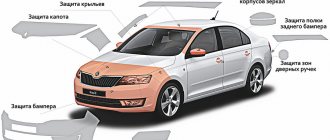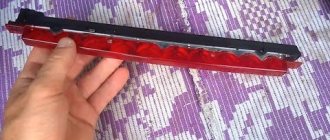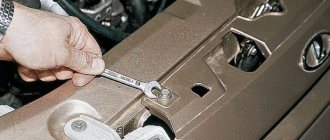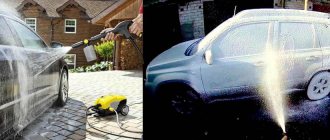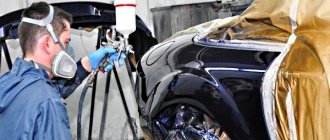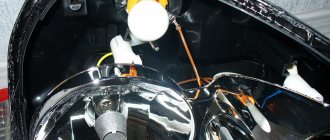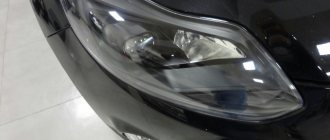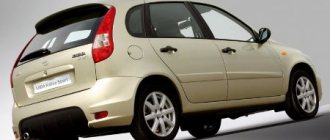Even on a new car, condensation may appear in the headlights.
Condensation is defined as the opposite of evaporation, where a gas changes into a liquid. Moisture collects on the coldest surface, from the inside of the lens (the transparent part of the headlight). In this article we will look at the causes of condensation in the headlight and how to eliminate them.
The nature of the condensate matters
The cause of fogging can be confirmed only by the nature of the condensation that has accumulated on the inner surface of the glass or plastic. If it is literally rain, then the premise is trivial:
- The product body is damaged.
- The front glass is poorly sealed.
- The cover on the back surface, which provides access to the lamps, is not tightly closed or is missing altogether.
Light mist with barely noticeable droplets indicates ventilation problems. To begin with, what is ventilation and why does optics need it?
Proper cleaning and assembly
- It is advisable to clean the disassembled headlight from dust and dirt. Glass and reflectors must not be washed with aggressive detergents or hot water. The best solution is a solution of laundry soap and a soft, lint-free rag. Don't rub!
- Then the washed components should be rinsed generously with distilled water and left to dry naturally.
- Assembly is carried out using clean cotton gloves. A special sealant for headlights is applied to the seam (at this stage you need to work carefully and avoid breaking the lines of the composition).
- The glass is connected to the body and dried at room temperature for 24 hours.
- Then you can check the tightness. To do this, the headlight is immersed with glass in water and held for several minutes. In this case, water should not get into the holes on the back wall.
How to get rid of problems if headlights sweat: video about cleaning ventilation ducts
You can eliminate fogging of the head optics yourself. The main thing is to take your time and choose the right materials. Prevention is even more important. You should periodically check that the breathers are clogged. Try not to drive at high speed through puddles with your headlights on, and let the headlights cool down before visiting a car wash. Then the headlights will fog up less often and you won’t have to remove them for drying.
High-quality ventilation is the key to success
The headlight housing is far from a vacuum. There is air inside, which expands when heated and goes out through the valves. As a result of the pressure difference, cold air at this moment flows in from the engine compartment. Due to physical laws, there must be at least two such valves: one for cold air, the other for hot air. And according to all the laws of nature, the “hot” breather is located at the top, and the “cold” breather is at the bottom.
The valve is a tube sealed with foam rubber. Is the body connected to the atmosphere? Linked. And the foam prevents dust from getting inside, which is why the lenses and other parts remain clean. This is a primitive optics ventilation scheme implemented on the vast majority of machines.
The premium segment uses solid illuminators that require proper cooling. Once upon a time, the Audi Q7 used turbines that worked like a home fan. They additionally force air into the headlight housing, which increases the air exchange rate.
On a "budget" basis, individual manufacturers also do more. For example, in the headlight housings of KIA cars there are sachets of silica gel. In the summer it dries well in the air, and in the autumn-winter period it perfectly absorbs moisture.
Why does moisture appear inside the car optics?
First, let's look at the design of modern head lighting. The headlights of the car are a single body with polycarbonate glass glued in with sealant. Inside there are reflectors, diffusers, and an adjustment mechanism.
Moisture affects all components of the optics
There are options with built-in lenses, including for gas-discharge lamps. In the case of standard xenon, there may be electronics inside the housing: control units and high-voltage lamp ignition units.
Contrary to the statements of some “experts,” the headlight housing is not sealed. The holes for installing lamps and bushings for electrical wiring are sealed with silicone or rubber gaskets. But when the lamp heats up, the air inside the housing expands and requires a hole to escape. For this purpose, any modern headlight is equipped with ventilation valves-breathers. They are located in strictly designated places, provide normal ventilation and are protected from accidental ingress of moisture.
It is better to disassemble lensed headlights according to the manual
Important! If the inside of the headlights is sweaty and condensation is forming, check the breathers first.
Causes of fogging:
- Ventilation holes clogged with dirt or blocked by the owner. Due to the temperature difference, condensation forms inside the case, and there is no ventilation.
- Cracks in glass or case. Unusual openings lead to direct water ingress and disrupt natural air circulation.
- Poor quality glass sealing after disassembling/assembling the headlight. For example, after unprofessional tuning.
- Fogging of headlights usually occurs during rain, car washing or at low air temperatures. In the first two cases, water enters directly through the damage; in the latter, condensation forms.
Condensation can accumulate both outside and inside
This is interesting: 3 cases when it is still possible to cross a solid line
How to get rid of foggy headlights
It is important to understand that disruption of the normal conditioning of the insides of the optics inevitably leads to fogging. And here it is necessary to keep in mind that the standard ventilation system may not have been fully developed from the factory, and this often happens. At the same time, dealers may not acknowledge the malfunction at all, leaving the owner alone with the problem.
In general, dealers can also be understood: there are no compelling reasons to classify condensation as a malfunction. The process is natural, and the moisture itself in no way interferes with the performance and quality of the lighting, such as risks that are eliminated by polishing the plastic or glass of the headlight. Indeed, with poor quality air exchange, the phenomenon is spontaneous in nature and appears more often in humid weather.
The only thing that can be alarming is the progressive rate of manifestation of the defect. In this case, the standard solution is to replace the headlight ventilation system valves with new ones. When looking for a replacement, it is important to know the exact number of breathers, the name and catalog number of the required part. Regarding the name, we note that it may not correspond to the required one. For example, instead of a valve, the product is referred to as a “lid.”
Having a reserve of time and money, it is better to hold off on ordering. Remove the headlight and carefully inspect it for additional plugged holes. They can be adapted for additional valves, thereby making air exchange more intense. Just be careful: often additional tides have an identical configuration, but in fact they differ in size and the factory valve may not fit into this place.
However, car owners are not always limited to factory parts. Often improvised materials are used, such as corrugated tubes of various diameters and foam rubber. Sometimes foam rubber is replaced with padding polyester, as a more advanced material in terms of dust protection. One way or another, additional holes are only for the good.
How to eliminate the causes of water appearing on lighting fixtures
- It is necessary to disconnect all power and control cables, and if there is a hydraulic corrector, disconnect the hoses.
- Remove the headlight housing and clean it of dust and dirt. Check the drainage holes - they often become clogged with dirt. Clean the drainage hoses.
- Check the condition of the O-rings in the connectors and lamp sockets. Replace damaged elements.
- Inspect the headlight housing and glass for visible cracks. Repair minor damage with headlight repair sealant. Try not to use compounds with volatile components: ammonia, acetone, etc. Vapors can settle on the reflector, forming a white coating.
- If during these measures the causes of fogging were not identified, it means that the tightness of the connection between the case and the glass has been broken. In this case, you will have to disassemble the headlight and remove the old seal, replacing it with a new one. Some designs allow you to add sealant along the edge of the glass without compromising the appearance.
Important! Use compounds intended for repairing headlights. Conventional construction acrylic sealant is not designed for such operating conditions.
How to remove condensation from optics without removing them
Automakers don't take the problem seriously mainly because it appears and disappears spontaneously. And to speed up drying, just place the car's headlights in direct sunlight. Not only the sun can act as a catalyst for the process:
- Warm environment. Drive the car into a warm garage box, unscrew the covers that provide access to the lamps and leave the car overnight. Be sure to return the covers to their place before traveling.
- Warm air flow. A household hair dryer will quickly deal with condensation that has settled on the inner surface of the headlight.
- Silica gel. Heat it thoroughly in a frying pan, wrap it in a sock and put it inside the headlight so that it can be removed in the future.
Physical roots of the phenomenon
Before talking about how to eliminate fogging of headlights in a car, let's look at the nature of this phenomenon from the point of view of physics. This will help us understand what measures are needed to solve the problem of foggy headlights.
From a high school physics course we know that the air contains water particles - their ratio to other components can be greater or less, it depends on the level of humidity. The vaporous state of water particles is determined by their temperature - when heated, water turns into a gaseous state. During the cooling process, the steam again turns into a liquid and condenses into water droplets.
The temperature inside the optics is quite high, but the outer surface of the glass has a lower temperature due to contact with cold air - this leads to drops of moisture condensing on it, and the headlight fogs up.
The design of the headlights on the car is designed in such a way as to take into account fogging of the headlights - special ventilation holes are provided. They have special valves that serve to circulate air while protecting the interior from moisture and fogging. However, despite this, you may see that even on a new car the taillight or headlights are sweating - then you need to figure out what the cause of the fogging is.
Diagram of air flow in the headlight
The breather is clogged, what should I do?
The check valve design is not the same everywhere. But the operating principle is identical. Sometimes the valve may not close and remain in the open position. Air enters through this hole and causes condensation to form. Of course, you can replace the part, but you can do it differently.
Place a small bag of silica gel inside the headlight. These balls absorb moisture. It is important to place the bag in a suitable place. It should not be placed near a light bulb. It won't be able to burn, but it will melt. One sachet is enough for about autumn-winter.
You can dry the accumulated condensation with a hair dryer. This must be done carefully, otherwise under the influence of high temperature, the plastic may become deformed. Try to constantly move the hair dryer and not hold it too close. The good thing about this method is that you don’t need to remove the headlight from the car.
The problem can also be solved as follows; remove the seal cap from the headlight and drive like this for a while. The engine temperature will evaporate the condensation. Then close the seal cap tightly. There is a risk of dust and other debris from driving on dirt roads. So try to avoid this.
You can create additional ventilation by drilling a small hole at the bottom of the headlight. Sometimes, factory ventilation is not enough, and therefore additional holes are made. It often happens that the hole aggravates the situation. Then you can simply seal it.
Removing condensation from a headlight is not so difficult. You will have to tinker, but it will take a little time.
Reasons why optics sweat
If the headlight sweats, what should you do? To answer this question, it is necessary to conduct a detailed inspection of the optics - this will help to identify the cause of fogging and take the necessary measures. Below we provide a list of the main phenomena that can cause a headlight to fog up:
- The seal of the lantern is broken - check the joints and rubber seal. They can be broken, allowing moisture particles to get inside. Chewed rubber seals and worn-out sealant can let water through when washing the car, etc.
- The presence of cracks on the surface of the glass or in the body of the flashlight can also lead to the fact that the interior of the flashlight is constantly filled with moisture.
- Clogged ventilation duct, through which air circulates inside the optics. When the temperature inside rises, the air expands and comes out; when it cools, it contracts and is sucked in. Violation of this process can also cause the headlight to fog up.
If the headlights on a new car are sweating, the reason may be a manufacturing defect - the manufacturer could have made them insufficiently sealed. In this case, inspect the rubber seals, seams sealed with sealant, and make sure there are no cracks or other manufacturing defects on the body.
If the lights fog up on a new car, the problem may be that the air circulation channels are clogged - this happens quite often. Sometimes this can be a consequence of a recent accident - the impact causes cracks in the body and other damage that violate the tightness of the structure. In this case, they need to be identified and eliminated - if repair is impossible, the lamp will need to be replaced.
Using silica gel you can get rid of condensation in headlights
fox-spb › Blog › Why do headlights fog up?
Good afternoon, dear readers and guests, as well as subscribers of my blog!
In today's article we will look at the reasons for headlight fogging. Why does moisture accumulate inside and how to deal with this problem?
This is a common phenomenon faced by owners of new and used cars. As a result of the accumulation of condensation, not only the appearance of the car suffers, but also the ability of the headlight to illuminate the road deteriorates. Moreover, frequent fogging leads to fading and degradation of the reflective elements inside the headlight.

